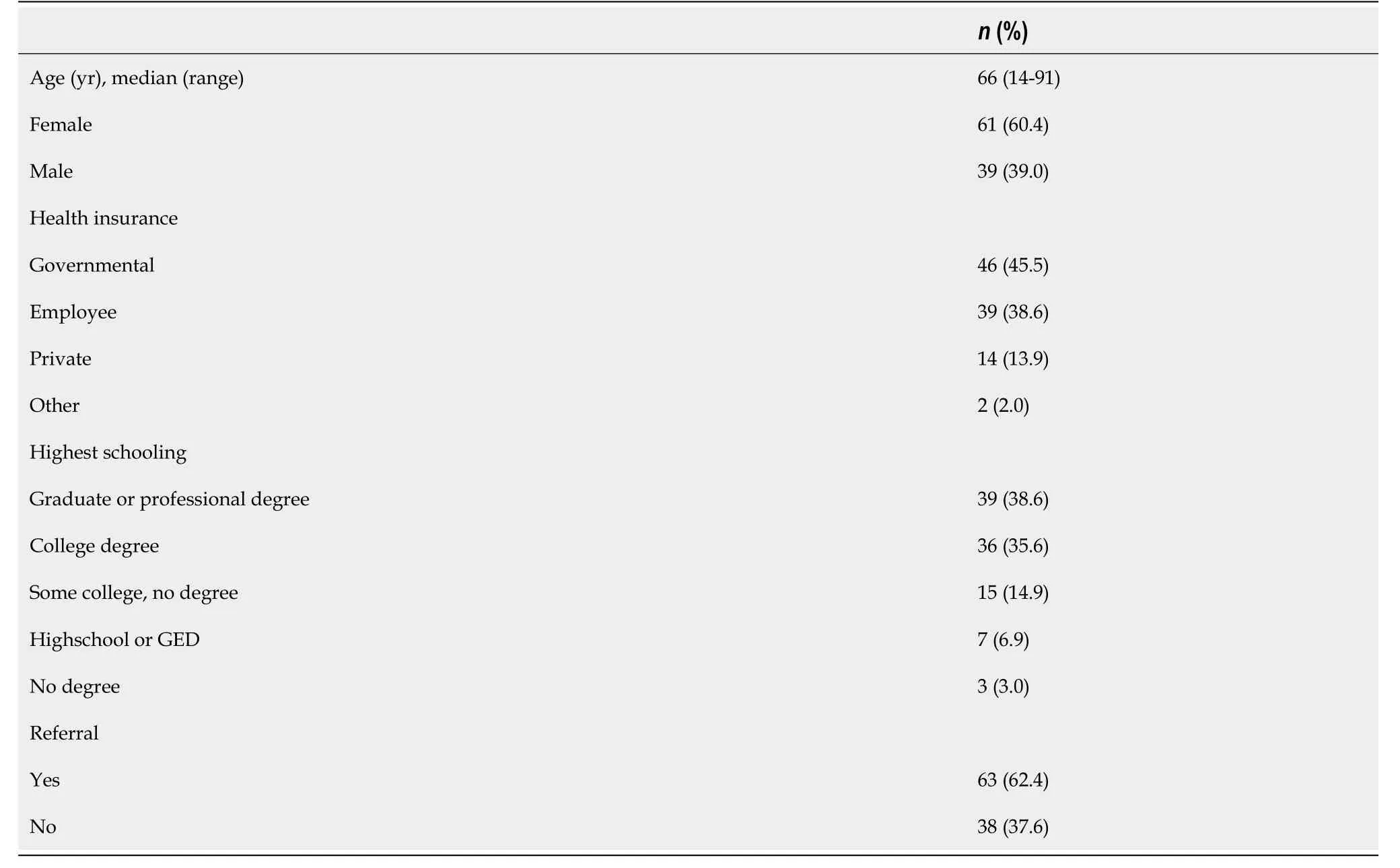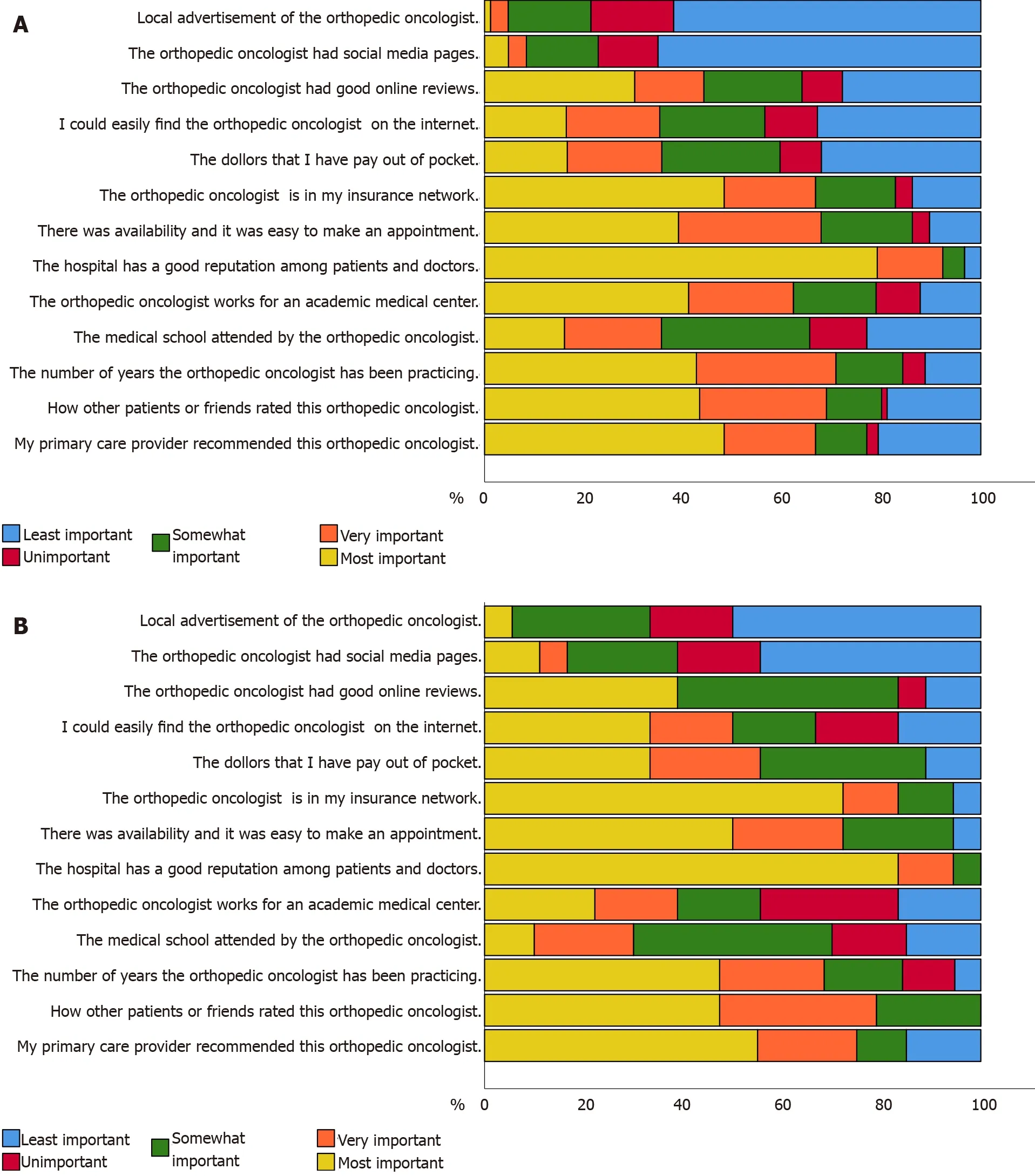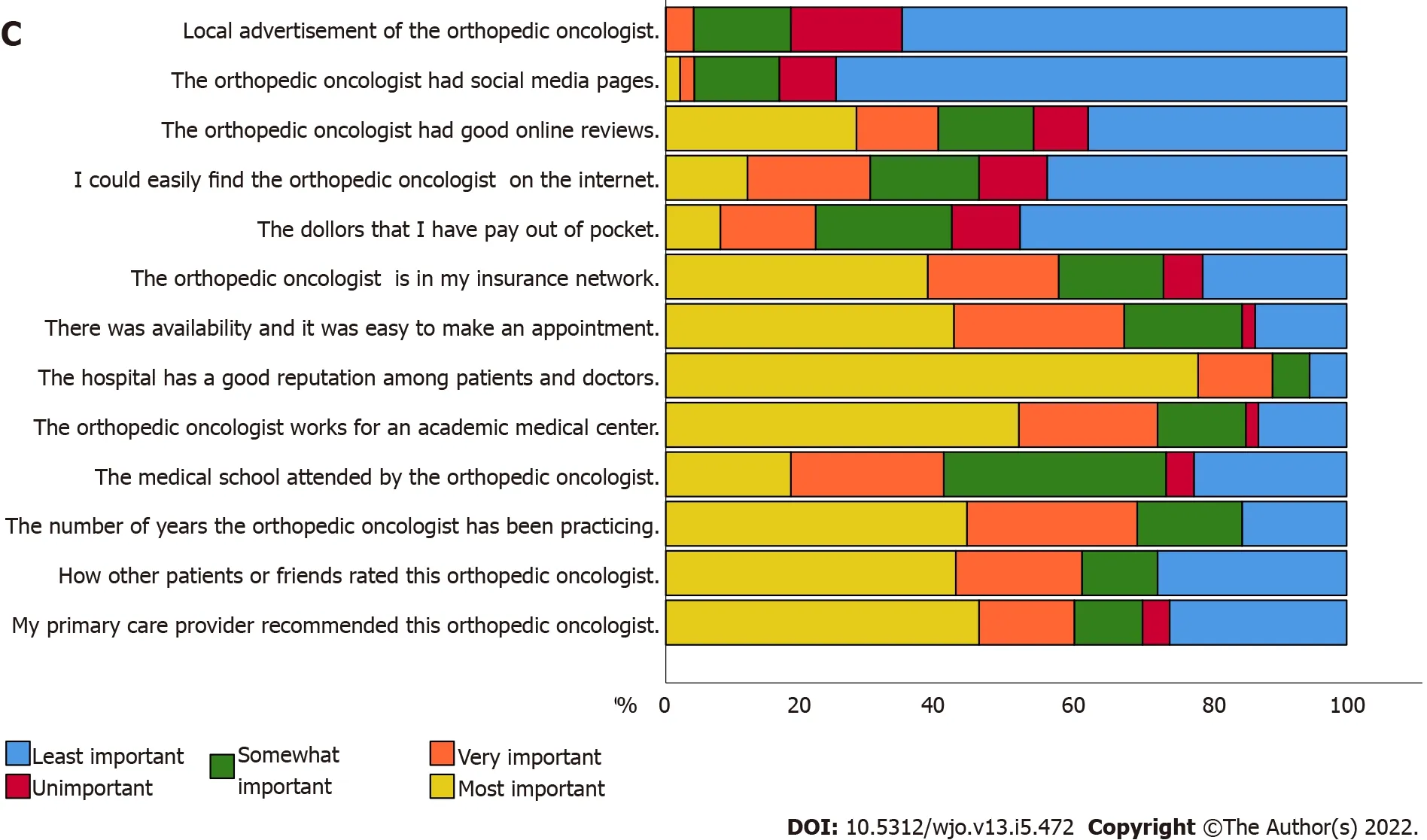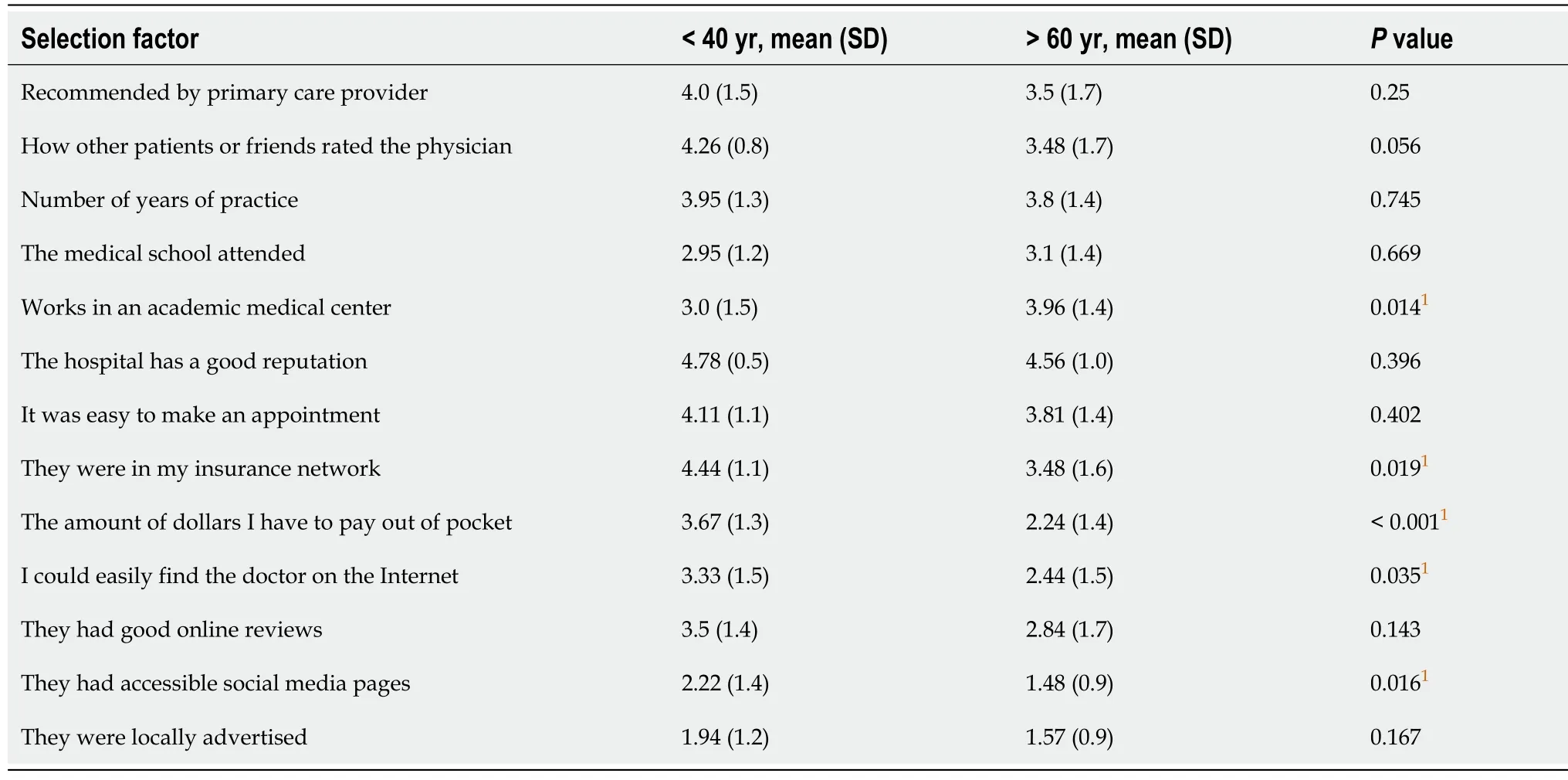What factors are important to new patients when selecting an orthopedic oncologist?
lNTRODUCTlON
Consumer-driven health plans have increased the demand for transparency in the quality of care[1]. As the quality of care influences patient satisfaction, understanding how patients choose a provider may improve the overall experience by identifying ways to tailor a clinical practice.
There are few data to inform how patients choose a physician, and these studies are largely focused in primary care or medicine specialties[2-5]. In medical oncology, it appears most patients utilize the Internet when researching a condition, though it is unclear whether such resources are used when subsequently selecting a provider[6]. In orthopedic surgery, the physician manner and ease of scheduling availability appear to impact the decision of where to establish care, though factors such as age, race, and sex of the provider are less important[7-11]. While there is evidence to inform how a patient chooses an orthopedist, however, these data largely pertain to elective surgery where the underlying condition does not carry the same magnitude as an orthopedic oncologic diagnosis.
This study sought to identify factors that new patients consider important when choosing an orthopaedic oncologist. We hypothesize younger patients would utilize social media and the Internet when choosing a surgeon, whereas older patients would identify a primary care referral and physician reputation as highly important.
MATERlALS AND METHODS
Design
Following Institutional Review Board approval, all new patients presenting to an orthopedic oncology clinic between January 2019 and August 2020 were invited to complete an anonymous survey. The clinic is located within a tertiary academic institution in major metropolitan area. Within three to five miles there are several oncologic choices each with an equivalent reputation. Inclusion criteria were new patients who initiated oncologic care with the senior author in the aforementioned time frame. There was no exclusion by age. Prior to completion of the survey, each eligible patient received a short cover letter describing the study. The subsequent questionnaire was designed using REDCap and consisted of 27 survey items[12]. The first category included demographic questions regarding age, sex, health insurance provider, referral status, and highest level of schooling. Age was also converted to a categorical variable considered conceptually meaningful based off a consistent pattern of ages seen in our clinic. The second category assessed utilization of social media (Facebook, Instagram, and/or Twitter) and the Internet (Healthgrades.com, RateMDs.com, Vitals.com, WebMD.com). The final category was a five-point Likert-type scale evaluation of various factors considered to be of importance in choosing an orthopedic oncologist[4]. The importance of each factor was scaled from least important(1) to unimportant (2); somewhat important (3); very important (4); and most important (5).
The body, she knew, could do no harm to any one, but the spirit could pursue the lonely wanderer, attach itself to him, and demand to be carried to the churchyard, that it might rest in consecrated ground
Statistical analyses
Continuous and categorical data were analyzed using descriptive statistics and reported as the median and range or mean and SD. Each Likert-type response was converted to a numerical variable and represented as the mean and SD. Mean responses to each factor from the Likert scale were compared between those less than 40 years of age and those older than 60 years of age using a two-sample-test.values were not corrected for multiple hypotheses as the analyses were primarily exploratory in nature.When possible, all available data were included for analyses. Statistical significance was set to avalue of less than 0.05, and all analyses were performed using SPSS version 26.0 (IBM Corp., Armonk, NY,USA).
All new patients presenting to an orthopedic oncology clinic were invited to complete an anonymous survey consisting of 27 questions that identified patient demographic factors, patient social media utilization, and patient identified factors on a Likert scale that are important to selecting an orthopedic oncologist.
RESULTS
Demographics
This study also found the individual physician reputation to be a strong selection factor, which is consistent with how outpatients choose other orthopedic specialists[13]. Though in contrast, the orthopedic oncologist sees new patients of a variety of different ages, often with morbid diagnoses. The presenting demographic consists of children and young adults, as well as parents of those children, in addition to the middle aged and elderly. In an era where use of the Internet and social media has become ubiquitous, the potential to reach patientsthese platforms has increased tremendously. Chen[6] note the media and Internet offer a profound means of medical information dissemination in cancer care, though they caution strategic efforts are needed to improve the quality of reporting and transparency of certain diseases. Additionally, social media and internet advertisement and outreach may closely be intertwined with profit-driven incentivization; therefore, further care should be taken by patients when selecting physicians. In the current study, we sought to determine whether the Internet presence was an important selection factor when choosing an orthopedic oncologist, and it appears the majority of patients neither utilize these resources nor consider it to be highly important.

Visit details
The majority of new patients were referred by another doctor (= 63, 62.4%), and of the referring providers the most frequent specialty was orthopedic surgery (= 32, 51%), followed by family practice(= 16, 25%), ‘Other’ (= 20, 32%), and medical oncology (= 7, 11%). The majority of new patients (=72, 71.3%) did not utilize social media or the Internet prior to their encounter (Table 2).
She represented to him what a powerful enchanter Grumedan was, and how, if he were provoked, he might avenge30 himself upon the Princess, since he was the most unjust and churlish of all the enchanters, and had often before had to be punished by the Fairy Queen for some of his ill-deeds

Selection factors
Among all responders, the most important selection factor was the hospital having a good reputation from other patients or doctors (mean, 4.65; SD, 0.85) (Figure 1A). Additional factors of importance were the number of years the orthopedic oncologist has been in practice (3.87 ± 1.3), how other patients or friends of patients rated the surgeon (3.73 ± 1.5), ease of scheduling availability (3.83 ± 1.3) and an innetwork provider (3.84 ± 1.4), and whether the patient’s primary care provider referred the patient (3.71± 1.6).


Factors by age group
Age was then categorically grouped into those younger than 40 years of age (Figure 1B;= 20), 40 years to 60 years (= 16), or older than 60 years of age (Figure 1C;= 50) (Table 3). Patients younger than age 40 identified social media (= 0.016) and Internet (= 0.035) presence of their provider as more important compared to patients older than age 60. In contrast, older patients considered working within an academic center to be of greater importance when selecting an orthopedic oncologist (= 0.014).

DlSCUSSlON
The findings of the current study suggest a primary care provider referral is one of the most important factors that new patients consider when choosing an orthopedic oncologist. Additionally, a good hospital reputation, locating an in-network provider, and the number of years in practice were important selection factors.
The response rate was 24% (= 101/426). Demographics are listed in Table 1. The median age was 66 years (range, 14 years to 91 years) and the majority were female (= 61, 60.4%). With respect to health insurance, 45.5% (= 46) had governmental insurance, 38.6% (= 39) had employee insurance, 13.9% (= 14) had private insurance.
When grouped by age, however, new patients younger than 40 years old identified social media and Internet presence of their surgeon to be of greater importance than older patients. While this finding is no surprise given the trends in social media utilization by younger generations, the implications for practice expansion are worth noting. For example, children and adolescents seen by orthopediconcologists typically undergo surgery for primary tumors of bone. One such procedure, the rotationplasty, is at first sight a cosmetically unappealing option for new patients and their families. However,some studies demonstrate favorable long-term functional outcomes and a high quality of life after this procedure[14]. In this instance, social media may allow the public (including young patients who use social media) to see the positive outcomes of rotationplasty. This tactic can certainly increase the transparency of cancer care, though also help a new patient and their family make a decision regarding where to pursue care. If appropriate, the orthopedic oncologist might utilize individual patient testimony to further promote these and other procedures with demonstrated efficacy, and social media may provide an outlet to do so given the importance of this selection factor in younger patients.
It was an automobile3 accident when I was twelve, Amy explained. I was readingto my younger brother in the back seat and suddenly my mother screamed and tried frantically6 to miss the truck that had pulled out in front of us. When I woke up in the hospital, my mother was screaming again outside the door. This time she was trying to escape the fact that I would never walk again.
One unique finding of the current study is that older patients placed a higher emphasis on the importance of seeking care within an academic medical center compared to younger patients. It is difficult to draw conclusions regarding this discrepancy by age, though one explanation is that older patients may have been treated in the same academic center and are simply new to the orthopedic oncology section itself. Another explanation is the perceived association of a higher quality of care with larger, higher volume centers. This may be in contrast to decisions made when choosing a hospital for other orthopedic procedures such as primary arthroplasty. Moser[15] found that selecting a hospital for arthroplasty is extremely complex, and often an individualized process with no real discernable preference towards higher volume centers in their cohort. For orthopedic cancer diagnoses, the magnitude of the underlying condition is often greater, and a higher volume center may indicate a more experienced multidisciplinary team which may motivate a new patient to seek care at one of these facilities. Furthermore, the current responders chose years in practice as a strong selection factor, and such providers may be located within these high volume centers. However, it is also likely that new patients are generally unaware of the multidisciplinary effort, and simply choose a hospital on familiarity of the name or proximity to the facility.
Her brothers and sisters were all astonished at her appearance, as they had never expected to see her again, and there was no end to the questions they asked her
As this study was a survey design, the findings may not be applicable to orthopedic oncologists in a different practice setting. Second, the overall response rate was 24%, which is low, though appears to be consistent with response rates from other survey studies used to identify selection factors[4,8,16]. Third,the question items of this survey were not validated, and in certain instances, patients omitted answers.As a large amount of the surveyed patients were of an advanced age, we believe that administering a surveyREDCap (electronic mailed survey) resulted in a lower yield than would be expected if they were approached in a clinical setting. Last, the patients seen in this practice are of a heterogenous group of diagnoses, ranging from incidental findings to aggressive malignancies, and the factors that influence choosing an orthopedic oncologist may vary by diagnosis. However, given the potential for recall bias,we did not inquire about any underlying diagnoses.
CONCLUSlON
The findings of this investigation suggest a primary care referral, a good hospital reputation, and a good physician reputation are among the most important factors when selecting an orthopedic oncologist.Furthermore, younger patients found social media and Internet presence of their surgeon to be more important than older patients, which may highlight an area for practice expansion when advertising to this group.
ARTlCLE HlGHLlGHTS
Research background
The study was reviewed and approved by the Rush University Medical Center Institutional Review Board (Approval No. 20072108).
Research motivation
Better understanding what factors patients deem important in their process of selecting a physician may allow for better tailoring of a clinical practice.
Someone is just dead! 12 said the little girl; for her old grandmother, the only person who had loved her,13 and who was now no more, had told her, that when a star falls, a soul ascends23 to God.14
Research objectives
This study aimed to identify the factors that patients deem important in selecting an orthopedic oncologist with whom to establish care.
Research methods
When I finally had my frozen yogurt and my friend was still complaining about the embarrassment47 I had caused her; I felt gratitude48 well up within me. At that very moment, I didn t care anymore what other people thought. I was going to do the right thing, even if it meant losing or embarrassing my friends. I smiled to myself because even though I had helped that lady in such a small way, she had helped me more by showing me how I could be different in the world and how good that could feel.
Research results
Strong hospital reputation, primary care referral, and physician reputation were among the strongest selection factors among patients. While hospital reputation may not be adjustable by the individual orthopedic oncologist, it appears important for surgeons to network with primary care providers to increase referrals in order to grow one's practice.
Research conclusions
The most important factor for patient selection overall was a good reputation of the hospital. Other important factors were the number of years in practice of the orthopedic oncologist, referral from the patient's primary care provider, and how other patients rated the surgeon. Social media and Internet presence of the surgeon was more important to patients under the age of 40 and those over the age of 60 felt it more important that the surgeon work in an academic center.
“This is exactly what we think,” they all replied, and then the music-master received permission to exhibit the bird to the people on the following Sunday, and the emperor commanded that they should be present to hear it sing. When they heard it they were like people intoxicated; however it must have been with drinking tea, which is quite a Chinese custom. They all said “Oh!” and held up their forefingers and nodded, but a poor fisherman, who had heard the real nightingale, said, “it sounds prettily enough, and the melodies are all alike; yet there seems something wanting, I cannot exactly tell what.”
Research perspectives
Future studies could investigate selection factors for patients who come to orthopedic oncology for second opinions after having been evaluated elsewhere.
FOOTNOTES
Gusho CA and Patel V contributed to the data collection, analysis, interpretation, drafting,editing, and revision; Lee L contributed to the interpretation, drafting, editing, and revisions; Blank AT contributed to the conception, oversight, editing, and revision.
There have been efforts to elucidate what factors patients use to select medical oncologists and orthopedic surgeons, but no studies have specifically investigated the patient selection factors for orthopedic oncologists.
At last the young man gave in, and threw the fish back into the sea; and both brothers went supperless to bed, and wondered what fortune the next day would bring
All study participants, or their legal guardian, provided informed written consent prior to study enrollment.
For clinics within a large metropolitan area such as the one in the current study, physician outreach is essential to a growing practice. The orthopedic oncologist and hospital alike must place an emphasis onthe importance of being readily available to patients. Additionally, the hospital and surgeon must also make the practice attractive to new patients by highlighting instances of outstanding care and favorable outcomes. Bozic[7] found orthopedic patients express desire to seek information regarding the quality of the provider, though note accessible and actionable information sources are often lacking.While this can be overcome with more frequent advertisement, the current study also found a majority of patients regardless of age chose an orthopedic oncologist based on the recommendation of their primary care provider. In total, 62% were referred, most commonly from an orthopedic surgeon or family doctor. Thus, with respect to expanding the practice or maintaining a favorable reputation, these data imply it may be beneficial to for an orthopedic oncologist to contact referring providers, which not only expands the practice, but contributes to the continuity of patient care. Such an interaction may certainly impact the reputation of the orthopedic oncologist as well.
Blank AT is Editorial or governing board of,,and; stock or stock options for exparel/pacira; ad hoc reviewer of; board or committee member of Musculoskeletal Tumor Society; Paid consultant of Onkos Surgical; receives research support from Swim Across America Cancer Research Grant; and all other authors have no pertinent financial disclosures or pertinent conflicts of interest.
The data that support the findings of this study are available from the corresponding author upon reasonable request.
This article is an open-access article that was selected by an in-house editor and fully peer-reviewed by external reviewers. It is distributed in accordance with the Creative Commons Attribution NonCommercial (CC BYNC 4.0) license, which permits others to distribute, remix, adapt, build upon this work non-commercially, and license their derivative works on different terms, provided the original work is properly cited and the use is noncommercial. See: https://creativecommons.org/Licenses/by-nc/4.0/
United States
Charles A Gusho 0000-0002-8897-3688; Vishal Patel 0000-0003-0446-4147; Linus Lee 0000-0002-3790-9061; Alan T Blank 0000-0003-2531-5976.
Wang JL
A
She took her sons shopping. Clerks gasped14 when her sons made grunting15 sounds. And now, she knew about the other women. Sometimes her husband didn t bother to come home. Her friends quit calling her and Marianne felt a biting loneliness.
Wang JL
 World Journal of Orthopedics2022年5期
World Journal of Orthopedics2022年5期
- World Journal of Orthopedics的其它文章
- Coronal plane deformity around the knee in the skeletally immature population: A review of principles of evaluation and treatment
- Update in combined musculoskeletal and vascular injuries of the extremities
- lnsufficient lateral stem contact is an influencing factor for significant subsidence in cementless short stem total hip arthroplasty
- Distal femur complex fractures in elderly patients treated with megaprosthesis: Results in a case series of 11 patients
- Prevalence and factors of work-related musculoskeletal disorders among hand surgeons
- Anterior vertebral body tethering for idiopathic scoliosis in growing children: A systematic review
